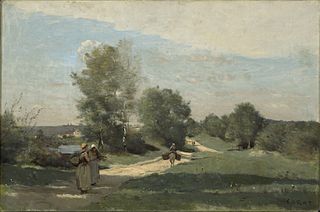
Fontainebleau is a commune in the metropolitan area of Paris, France. It is located 55.5 kilometres (34.5 mi) south-southeast of the centre of Paris. Fontainebleau is a sub-prefecture of the Seine-et-Marne department, and it is the seat of the arrondissement of Fontainebleau. The commune has the largest land area in the Île-de-France region; it is the only one to cover a larger area than Paris itself. The commune is closest to Seine-et-Marne Prefecture, Melun.

Seine-et-Marne is a department in the Île-de-France region in Northern France. Named after the rivers Seine and Marne, it is the region's largest department with an area of 5,915 square kilometres ; it roughly covers its eastern half. In 2019, it had a population of 1,421,197. Its prefecture is Melun, although both Meaux and Chelles have larger populations.

The Barbizon school of painters were part of an art movement toward Realism in art, which arose in the context of the dominant Romantic Movement of the time. The Barbizon school was active roughly from 1830 through 1870. It takes its name from the village of Barbizon, France, on the edge of the Forest of Fontainebleau, where many of the artists gathered. Most of their works were landscape painting, but several of them also painted landscapes with farmworkers, and genre scenes of village life. Some of the most prominent features of this school are its tonal qualities, color, loose brushwork, and softness of form.

Narcisse Virgilio Díaz de la Peña was a French painter of the Barbizon school.

Barbizon is a commune (town) in the Seine-et-Marne department in north-central France. It is located near the Fontainebleau Forest.
Randpark is a suburb of the city of Johannesburg, South Africa. It is located in the northern suburbs of the City of Johannesburg.

The forest of Fontainebleau is a mixed deciduous forest lying sixty kilometres (37 mi) southeast of Paris, France. It is located primarily in the arrondissement of Fontainebleau in the southwestern part of the department of Seine-et-Marne. Most of it also lies in the canton of Fontainebleau, although parts of it extend into adjoining cantons, and even as far west as the town of Milly-la-Forêt in the neighboring department, Essonne. Several communes lie within the forest, notably the towns of Fontainebleau and Avon. The forest has an area of 250 km2 (97 sq mi).

Avon is a commune in the Seine-et-Marne department in the Île-de-France region in north-central France.

Fontaine-le-Port is a commune in the Seine-et-Marne department in the Île-de-France region in north-central France.

Larchant is a commune in the Seine-et-Marne department in the Île-de-France region. It is located on the southern edge of the Forest of Fontainebleau.

Fontainebleau State Park is located in St. Tammany Parish, Louisiana, on the north shore of Lake Pontchartrain. The park is 2,800 acres (1,100 ha) in size and was once the site of a sugar cane plantation and brickyard operated by Bernard de Marigny and later by his son Armand Marigny. The park has a multitude of habitats for birds.

Homorthodes is a genus of moths of the family Noctuidae.
Gisilia lerautella is a moth in the family Cosmopterigidae. It is found in France. It was described from the Fontainebleau forest, but is thought to be an introduced species.
Gibeauxiella is a genus of moths in the family Cosmopterigidae.
Gibeauxiella bellaqueifontis is a moth in the family Cosmopterigidae. It is found in France. It was described from the Fontainebleau forest.

The Antequerinae are a subfamily of the Cosmopterigidae. In the Nearctic, the subfamily consists of eight species in four genera, found in North America and England.

Terina is a genus of moths in the family Geometridae erected by Francis Walker in 1854.
Stilbosis extensa is a moth in the family Cosmopterigidae. It was described by Annette Frances Braun in 1919. It is found in North America where it has been recorded from California.
Homorthodes reliqua is a species of cutworm or dart moth in the family Noctuidae. It is found in North America.

Zapyrastra calliphana is a species of moth of the family Momphidae. It was first described by Edward Meyrick in 1889. It is found throughout New Zealand including at the Manawatāwhi / Three Kings Islands as well as at the Norfolk Islands. The preferred habitat of this species are native forest clearings, shrubland or coastal habitat such as scrub or dunes. The larvae of this species are leaf miners and are hosted by Muehlenbeckia species. There are likely several generations during the New Zealand summer and one generation overwinters as pupae. This species is a day flying moth and adults can be observed on the wing from October to March.













